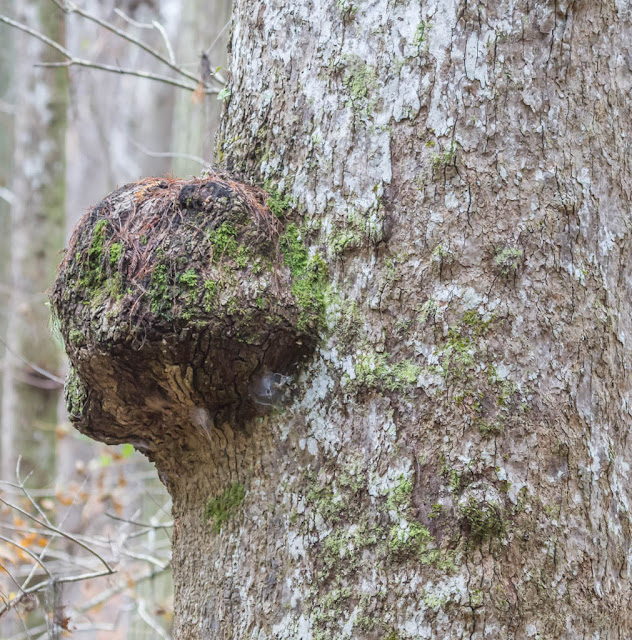Congaree NP rests along the meandering Congaree and Wateree Rivers near Columbia, SC. This beautiful park protects over 26,000 acres of old-growth bottomland hardwood forest, the largest such area left in the entire United States. Thankfully Congaree's trees escaped large-scale cutting because logging was especially hard here. The Bald Cypress forest is especially primeval and wonderful to traverse on a long, well-maintained boardwalk.
Shortly after we started on our 3 hour hike, at least 500 mosquitoes were assigned to each of our bodies, making part of the experience less than comfortable.
Cypress Knees
Bald Cypress Trees
Since this area has experiences such a warm fall so far, most of the trees still had lots of leaves which makes spotting birds more difficult. In situations like this we typically identify many more birds by sound than by sight.
Yellow-bellied Sapsucker (Male)
Notice the holes in the tree near the bird. Sapsuckers make two kinds of holes in trees to harvest sap. Round holes like most of these, extend deep in the tree and are not enlarged. The sapsucker inserts its bill into the hole to probe for sap. Rectangular holes are shallower, and must be maintained continually for the sap to flow. The birds lick the sap from these holes, and eat the cambium of the tree as well. Like here, new holes usually are made in a line with the old holes, or in a new line above the old.
And for the useless but fun fact of the day: a group of Yellow-bellied Sapsuckers is known as a "slurp!"
Those east of the Mississippi River are usually Yellow-shafted
Those west of the Mississippi R are typically Red-shafted, though their ranges overlap extensively. The red-shafted and yellow-shafted forms formerly were considered different species. The two forms hybridize in a wide zone from Alaska all the way to the panhandle of Texas. (A hybrid often has some traits from each of the two forms and some traits that are intermediate between them.)
Most flickers are resident or short-distance migrants. They tend to leave the northern parts of their range to winter in the southern U.S. Birds that typically breed farther south usually stay put for the winter.
American Robins were numerous
South Carolina's state bird, the Carolina Wren
22 foot diameter root ball
Lindsay and Kathy in front of another blowdown, courtesy of Hurricane Matthew's visit
Basketball-sized Burl
(A Burl is a try growth in which the grain has grown in a deformed manner. It is usually found in the form of a rounded outgrowth on a tree trunk or branch that is filled with small knots from dormant buds)
The one in Congaree NP is nothing compared to THE Burl in Port McNeill, BC
Fungi
A colorful beauty
An interesting spider web
Poison Ivy was common





























No comments:
Post a Comment